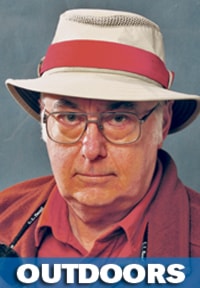Nov. 1, opening day of deer season in Wildlife Management Unit 324, is the last of this column’s really important days of the year. The others are April 1, opening day of the trout season, and Oct. 15, the pheasant opener.
There was a time when Alberta fishing seasons never closed; you could open yours any time you wanted, and pheasant season opening was variable, the first Wednesday after Thanksgiving.
Then, in the civilized days out in WMU 324, the big game season opened around Sept. 20 and ran until Nov. 30. In those good old days out there, I hunted early, in fine fall, warmish weather because I had learned that the best venison came from a fat, free-range fork horn mule deer taken in September.
From the first one I took as an equinoctial storm was blowing in during the early 1970s, I also learned to cool them quickly in very cold water because I “accidentally” floated that one out in a creek flowing in the same direction we wanted to go to get to my rig.
But the move to the fixed Nov. 1 opening date for only a one-month season changed things, added a sense of urgency, the feeling that you just have to go, get out there. It also added the risks and vagaries of the weather to the mix.
I had decided that 2012 would be the last serious season — with rifle — for me, and I had everything loaded in the rig to head out after a very early eye appointment on a foggy, snowy opening morning. As it happened, longtime hunting companion Mac Johnston was just ahead of me for his appointment with Dr. Leinweber.
But when I finished there were weather red alerts, road advisories and closures, so I went home. Hunting deer just before or just after a storm can be fantastic, but during the storm just doesn’t work.
Even without licence or rifle, I just had to get out there on opening day last year to watch the deer and see what else was going on. Nothing was. It was, as my late friend Lloyd Graff was often wont to say, “puuurty quiet”: bright, sunny, a bluebird day, no deer nor hunters seen for most of it, and not one shot heard.
There are hot spots on my own land where I would park my rig, aka “Mobile Ground Blind,” so the critters would get used to seeing it and regard it as “just that harmless old farmer,” a trick I learned from full-time farmers who got their deer every season that way.
At about 3 p.m. opening day, 2013, I sat in the rig at my hottest spot: watching the main trail into a small hay field the deer love because it can’t be seen from the road, It was still bright and sunny, but no sooner had the radio quietly warned that a severe blizzard was on the way than white tails were in the field, filling up ahead of the storm on second-growth alfalfa.
I watched for a while, then left, barely beating the blizzard home.
As we all shiver to recall, a blizzard week followed, wiping out the season for most hunters, and many deer died in snow as deep as three metres on the level. So this 2014 opening day, without deer tags or rifles, Mac Johnston and I just had to get out there in my rig to see if any deer, or deer hunters, had survived the worst winter many of us can remember.
It was mostly overcast, drizzly once in a while, but the blizzard was confined to the south. We encountered and spoke with only one hunter who had spent the morning in a well-located tree stand, saw no deer but did hear some distant shots. The next morning, 13 white tails passed by his stand and he took the 13th, a young four-by-four “basket” buck.
We all marvelled at the total destruction of one achingly scenic country road by Clearwater County, turning it into an expensive, graded and graveled 66-footer with fine four-wire fence both sides, which the one year-round and three seasonal residents down the road did not want. The county has too much money they just have to spend, so a perfectly serviceable scenic treasure is destroyed to “bring it up to spec.”
For a high noon lunch in a sunny period, Mac and I planned to eat in the rig parked at a strategic spot in that hidden hay field. As we entered the field, a buck and doe white tail fled back up the trail leading back to their bedding area; this old farmer’s rig just had not been around enough this summer to convince the deer that no harm was meant.
After lunch, there were a white tail doe and two fawns back in the Sand Hills. Now I’m worrying that we had not seen a single mule deer.
Bob Scammell is an award-winning columnist who lives in Red Deer. He can be reached at bscam@telusplanet.net.
